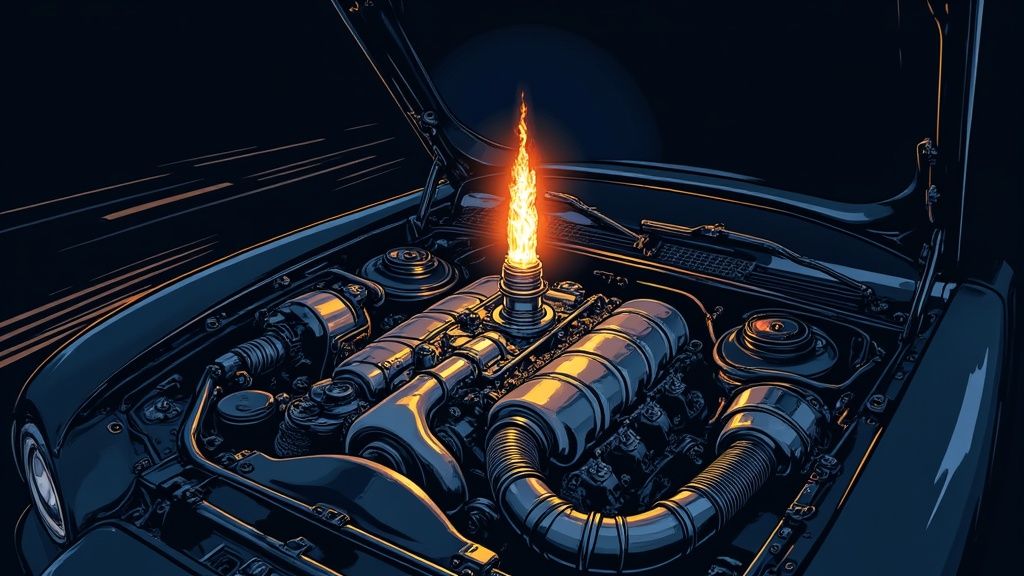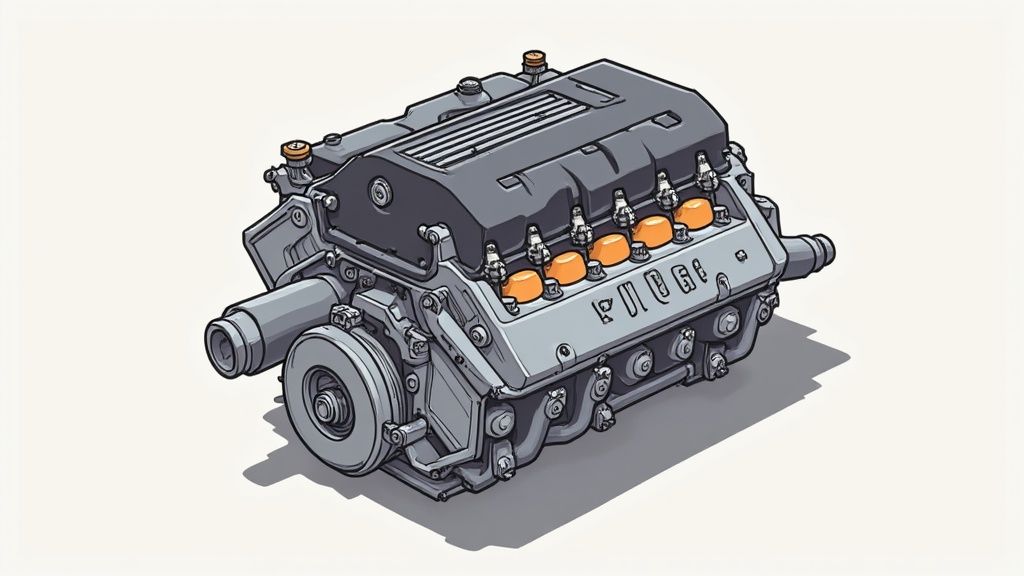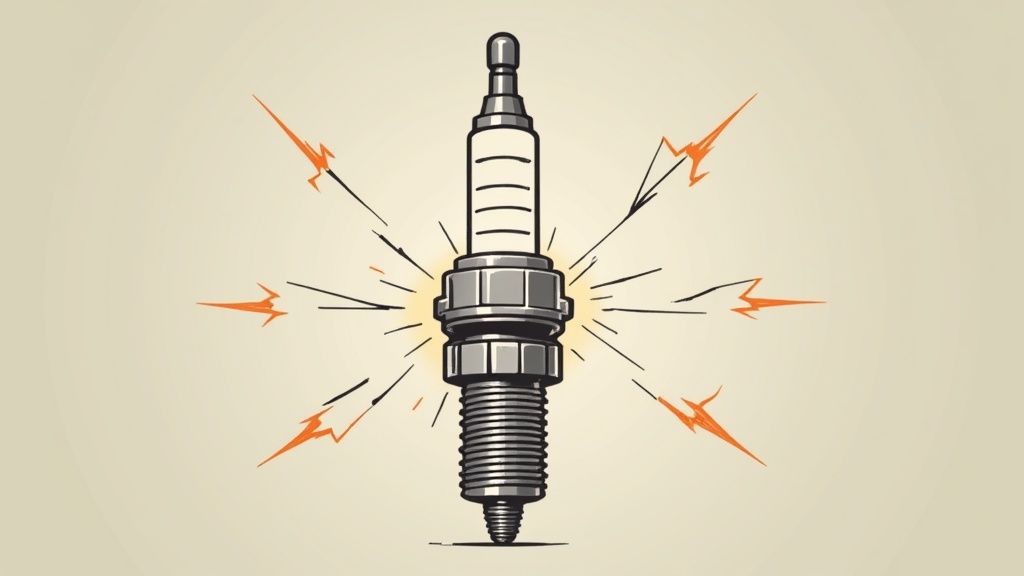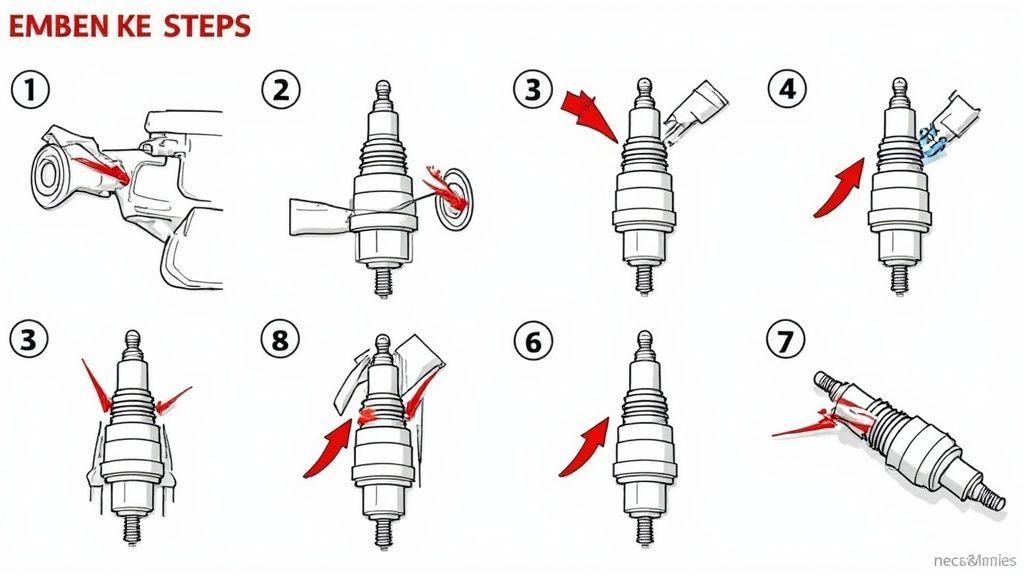
When to Replace Spark Plugs: Boost Engine Performance
The Truth About Spark Plug Lifespan

Knowing when to replace your vehicle’s spark plugs can be tricky. Many car owners replace them prematurely, leading to unnecessary expenses. Others wait too long, risking potential engine damage. This section clarifies spark plug lifespan and helps you make informed maintenance choices.
Spark Plug Types and Their Lifespan
The materials used in spark plugs directly influence their lifespan. Understanding these differences is essential for optimizing your vehicle’s maintenance schedule.
-
Copper Spark Plugs: These are the standard, most affordable option. They typically last 30,000 to 40,000 miles. The copper electrode wears down relatively quickly, resulting in a shorter lifespan.
-
Platinum Spark Plugs: These offer improved durability compared to copper, lasting between 60,000 and 100,000 miles. The platinum electrode’s harder composition resists wear more effectively.
-
Double Platinum Spark Plugs: Featuring a platinum disc on both the center and ground electrodes, these plugs offer enhanced durability. Their lifespan is similar to single platinum plugs, ranging from 60,000 to 100,000 miles.
-
Iridium Spark Plugs: Considered the premium option, iridium spark plugs offer exceptional longevity, often lasting over 100,000 miles. The iridium tip’s high melting point and erosion resistance contribute to this extended lifespan.
Selecting the right type of spark plug can significantly impact replacement frequency. However, these are just general estimates. Factors like driving habits and vehicle conditions can influence the actual lifespan of your spark plugs.
Factors Affecting Spark Plug Lifespan
While the spark plug type is a key factor, other elements contribute to their overall lifespan.
-
Driving Conditions: Frequent stop-and-go city driving puts more stress on spark plugs compared to consistent highway driving. Lower RPM operation in city driving contributes to increased wear.
-
Fuel Quality: Using lower-grade fuel can lead to deposit buildup on spark plugs. This affects performance and reduces their lifespan.
-
Engine Condition: Pre-existing engine issues, such as oil leaks or a malfunctioning ignition system, can also contribute to premature spark plug wear.
-
Vehicle Make and Model: Engine design and manufacturer recommendations play a role in determining the replacement interval. Spark plugs ignite the fuel-air mixture in your engine. The recommended replacement frequency varies based on the vehicle’s make and model, typically ranging from 30,000 to 100,000 miles. Factors like stop-and-go city driving can necessitate more frequent replacements due to increased engine strain. Signs of worn spark plugs include reduced fuel efficiency, increased engine noise, and difficulty starting. Learn more.
The Importance of Timely Replacement
Replacing spark plugs at the recommended interval ensures optimal engine performance and fuel efficiency. It also helps prevent damage to other engine components. Delayed replacement can lead to reduced fuel economy, rough idling, misfires, and potentially damage the catalytic converter.
By understanding the factors that influence spark plug lifespan and recognizing the warning signs of worn plugs, you can make informed maintenance decisions. This proactive approach keeps your engine running smoothly and efficiently, avoiding potentially costly repairs. Tracking your vehicle maintenance, including spark plug replacements, can be simplified using tools like an Auto Service Logger.
Decoding the Warning Signs Your Engine Is Sending

Your car often communicates when it’s time for new spark plugs, but are you paying attention? Recognizing the signs can prevent bigger problems down the line. This section explores those crucial warning signs, helping you understand what’s happening under the hood.
Common Symptoms of Worn Spark Plugs
Several symptoms can indicate failing spark plugs. These range from subtle changes in engine behavior to more obvious performance issues.
-
Rough Idling: A rough or shaky idle is often an early sign. This happens because worn spark plugs struggle to consistently ignite the air-fuel mixture, causing uneven engine operation at low speeds.
-
Engine Misfires: Misfires occur when one or more spark plugs fail to ignite the fuel. This can cause a noticeable power loss, often accompanied by a jerking or sputtering feeling.
-
Difficulty Starting: Worn spark plugs can make starting your engine harder, particularly in cold weather. This is because the weakened spark struggles to ignite the colder, denser air-fuel mixture.
-
Reduced Fuel Economy: Worn spark plugs contribute to incomplete combustion, meaning not all fuel is burned. This wastes fuel and reduces your miles per gallon.
-
Increased Emissions: Incomplete combustion also increases harmful emissions, potentially causing a stronger gasoline smell from the exhaust.
Diagnosing Spark Plug Problems
While these symptoms often indicate worn spark plugs, they can also be signs of other engine problems. Accurate diagnosis is crucial to avoid unnecessary repairs. A visual inspection of your spark plugs can offer valuable clues.
-
Appearance: Examining the spark plug’s electrode can reveal wear, fouling, or damage. A healthy spark plug typically has a relatively clean electrode, while a worn plug might have excessive erosion or deposits.
-
Testing: Testing your spark plugs with a spark plug tester can confirm whether they’re firing correctly. This simple test can quickly pinpoint a faulty plug.
Distinguishing Spark Plug Issues From Other Problems
Several other issues can mimic worn spark plug symptoms. A faulty fuel injector can cause misfires and rough idling, much like a bad spark plug. A clogged air filter can also decrease fuel economy. A professional mechanic can accurately diagnose the problem and recommend the right repair.
Understanding the Impact on Different Vehicle Types
The symptoms of worn spark plugs can vary between vehicles. A misfire might be a slight hesitation in one car but a noticeable jolt in another. Factors such as engine design, fuel system, and vehicle weight influence how these symptoms are experienced. However, noticing any change in your vehicle’s normal performance is crucial for early diagnosis and preventing further problems. By understanding the warning signs and knowing when to replace your spark plugs, you can maintain optimal engine performance, improve fuel efficiency, and protect your engine from potential harm. These small but vital components make a big difference. Tracking your vehicle’s maintenance, including spark plug replacements, with a tool like Auto Service Logger can greatly assist with timely maintenance and prevent costly repairs.
The Hidden Cost of Ignoring Worn Spark Plugs

Beyond the noticeable drop in vehicle performance, worn spark plugs quietly drain your finances. This hidden cost goes beyond the simple price of replacements. It’s about the extra money you spend on gas every time you fill up. This section explores the financial burden of driving with worn-out spark plugs.
The Fuel Efficiency Drain
Worn spark plugs significantly impact your vehicle’s fuel efficiency. The weakened spark struggles to fully ignite the air-fuel mixture, a problem known as incomplete combustion. This results in wasted fuel and more frequent trips to the gas station.
To compensate for the incomplete combustion and maintain power, the fuel injection system often injects more fuel. This exacerbates the fuel consumption problem, adding to the overall cost. A vehicle normally achieving 25 miles per gallon could see that drop to 17.5 miles per gallon with worn spark plugs.
This seemingly small difference in fuel economy adds up quickly. The Automotive Service Excellence (ASE) states that a misfiring spark plug can decrease fuel efficiency by as much as 30%. Regular spark plug replacement helps maintain optimal fuel economy. Learn more about spark plug replacement frequency.
Calculating the Real Cost
The actual cost of driving with worn spark plugs goes beyond just increased fuel consumption. It includes the potential for more costly damage to your engine. Continuous misfires can strain the catalytic converter, an expensive part to replace. Ignoring this problem can also lead to increased emissions, affecting both the environment and potentially your vehicle’s ability to pass emissions tests.
To illustrate the financial implications, consider a driver who travels 15,000 miles annually in a vehicle averaging 25 mpg. With worn spark plugs reducing efficiency to 17.5 mpg, this driver would consume an extra 214 gallons of fuel each year. At an average gas price of $4 per gallon, this equates to an additional $856 spent annually.
Let’s take a look at how this impacts different vehicle types in the following table:
Fuel Economy Impact of Worn Spark Plugs
This table illustrates the potential fuel economy losses from worn spark plugs across different vehicle types. Annual cost difference is based on 15,000 miles driven per year and a fuel cost of $4 per gallon.
| Vehicle Type | Normal MPG | MPG with Worn Plugs | Annual Cost Difference* |
|---|---|---|---|
| Compact Car | 30 | 21 | $714 |
| Sedan | 25 | 17.5 | $857 |
| SUV | 20 | 14 | $1,071 |
| Truck | 15 | 10.5 | $1,429 |
As this table shows, the added cost of driving with worn spark plugs can be substantial, varying depending on the vehicle type and its typical fuel efficiency.
The Return on Investment of New Spark Plugs
Replacing your spark plugs, costing between $50 and $80, offers significant long-term savings. This relatively small investment improves performance and prevents costly damage from reduced fuel efficiency and potential strain on other engine components.
By proactively addressing worn spark plugs, you protect your budget and maintain your vehicle’s health. Using a vehicle maintenance log, like Auto Service Logger, can help you track spark plug replacements and other maintenance tasks, ensuring optimal performance and cost efficiency. This proactive approach maximizes your vehicle’s lifespan and helps you avoid unexpected, and potentially large, repair bills.
When to Replace Spark Plugs Across Different Vehicles

Knowing when to replace your spark plugs is essential for maintaining your vehicle’s performance and fuel efficiency. The replacement frequency isn’t one-size-fits-all. It varies depending on several factors, including your vehicle’s make and model, engine type, and even your individual driving habits.
Understanding Manufacturer Recommendations
Your owner’s manual is the first place to look for guidance on spark plug replacement. Most manufacturers provide recommended replacement intervals, offering a solid starting point. However, these recommendations often assume ideal driving conditions.
Keep in mind that factors like frequent stop-and-go city driving or towing heavy loads can significantly impact spark plug lifespan. These driving styles put extra stress on the engine, leading to faster wear and tear on the spark plugs.
Vehicle and Engine-Specific Considerations
Engine type plays a crucial role in spark plug longevity. Turbocharged engines, operating at higher pressures and temperatures, tend to wear out spark plugs faster than naturally-aspirated engines. Similarly, the high RPM operation of high-performance vehicles puts increased demand on spark plugs.
Luxury vehicles often utilize specialized spark plugs, sometimes incorporating precious metals like platinum or iridium for enhanced performance and lifespan. While these plugs typically last longer, they also come with a higher replacement cost. For instance, specific BMW models often require particular spark plug types due to their unique engine designs, impacting replacement frequency. Likewise, a Toyota truck used for heavy towing will need more frequent spark plug changes compared to one used for daily commuting.
Spark Plug Material and Longevity
The material composition of the spark plug itself is a key factor in its lifespan. Copper spark plugs, the standard and most affordable option, typically last between 30,000 and 40,000 miles. Platinum and double platinum spark plugs offer increased durability, extending the replacement interval to 60,000-100,000 miles. For maximum lifespan, iridium spark plugs can often exceed 100,000 miles.
Creating a Personalized Maintenance Schedule
The optimal approach to spark plug replacement involves consulting your owner’s manual and factoring in your specific driving conditions. If you primarily drive in the city or frequently tow heavy loads, you’ll likely need more frequent replacements than the manufacturer’s recommendation. Conversely, consistent highway driving might extend the life of your spark plugs.
Maintaining detailed maintenance records, perhaps using tools like Auto Service Logger, allows you to create a personalized maintenance schedule. This proactive approach ensures timely spark plug replacements based on your driving habits and vehicle type.
The following table offers a general overview of spark plug replacement intervals by vehicle type. Remember to consult your owner’s manual for specific recommendations.
Spark Plug Replacement Intervals By Vehicle Type
This table provides general guidelines and should be used in conjunction with your owner’s manual and professional advice.
| Vehicle Make/Type | Engine Type | Plug Material | Replacement Interval (Miles) | Special Considerations |
|---|---|---|---|---|
| General Gasoline Engine | Naturally Aspirated | Copper | 30,000-40,000 | |
| General Gasoline Engine | Naturally Aspirated | Platinum/Double Platinum | 60,000-100,000 | |
| General Gasoline Engine | Turbocharged | Iridium | 60,000-100,000 | Check manufacturer recommendations, potentially sooner. |
| High-Performance Vehicle | Various | Iridium/Platinum | As per owner’s manual | Severe driving conditions may shorten lifespan. |
| Truck (Towing) | As per owner’s manual | More frequent changes if used for heavy towing. | ||
| Luxury Vehicle | Varies | As per owner’s manual | Often use specialized plugs. |
By understanding these factors and proactively tracking your vehicle’s maintenance, you can optimize engine performance and avoid unnecessary costs associated with neglected spark plugs.
DIY vs. Professional Spark Plug Replacement: Making The Right Call
Replacing your spark plugs is essential vehicle maintenance. However, deciding between a DIY job and hiring a professional can be tough. It’s not simply about cost, but also understanding the job’s complexities and potential risks. This section guides you through the pros and cons of each approach, helping you make the best decision for your situation.
DIY Spark Plug Replacement: Benefits and Risks
The primary appeal of DIY spark plug replacement is cost savings. You only pay for parts, avoiding labor costs. This is a significant advantage, especially if you’re mechanically inclined and enjoy working on your car.
-
Benefits:
- Cost Savings: DIY eliminates labor charges, significantly lowering the overall expense.
- Sense of Accomplishment: Successfully replacing your spark plugs can be personally rewarding.
- Control Over the Process: You choose the parts and ensure the job meets your standards.
-
Risks:
- Cross-Threading: Incorrect spark plug installation can damage the cylinder head threads, a costly repair.
- Improper Gapping: An inaccurate spark plug gap reduces performance and fuel economy.
- Breaking Spark Plugs: Over-tightening or incorrect tools can break a spark plug, requiring specialized extraction.
- Time Commitment: Replacing spark plugs can be time-consuming, particularly for those unfamiliar with the process.
Professional Spark Plug Replacement: Peace Of Mind and Expertise
Choosing a professional provides peace of mind knowing the job will be done right. Certified mechanics possess the expertise and tools to handle complications, ensuring correct installation and minimizing damage risk.
-
Benefits:
- Expertise and Experience: Mechanics are trained to work on various engine types and spark plug installations.
- Specialized Tools: Professionals use the correct tools, avoiding common DIY issues.
- Warranty: Many repair shops provide warranties on their services, protecting you from faulty installations.
- Time Savings: Experienced mechanics complete the job quickly and efficiently.
-
Risks:
- Cost: Professional replacement includes labor, making it more expensive than DIY.
- Finding a Reputable Mechanic: It’s crucial to find a trustworthy mechanic who uses quality parts and charges reasonable prices.
Accessibility: Modern Engine Designs
Modern engines are often compact, making spark plug access more difficult than in older vehicles. Some engines require removing the intake manifold or other components to reach the spark plugs, increasing complexity and replacement time. This often makes professional replacement the more practical choice.
Making The Informed Decision
Ultimately, the DIY versus professional decision depends on your comfort level, mechanical skills, available time, and your engine’s design. If you’re unsure, consulting a trusted mechanic offers valuable insights. They can assess your vehicle’s accessibility and provide personalized advice.
Regularly logging your vehicle’s maintenance, including spark plug replacements, with a tool like Auto Service Logger helps you stay organized. This tracks your maintenance history, regardless of whether you choose DIY or professional service, which is helpful for warranty claims or when selling your vehicle. By weighing these factors and making an informed decision, you can ensure your vehicle runs smoothly and efficiently.
Selecting The Perfect Spark Plugs For Your Engine
After understanding when to replace spark plugs, choosing the right type for your engine is crucial. The variety of spark plugs available, each with different materials and performance claims, can be overwhelming. This section clarifies the key differences between spark plug types and helps you select the ideal choice for your vehicle.
Understanding Spark Plug Materials
Spark plugs are mainly differentiated by the material used for their electrodes. This material impacts the plug’s performance, lifespan, and cost.
-
Copper Spark Plugs: These are the most common and affordable option. Copper’s excellent conductivity effectively generates sparks. However, its softer nature means it wears down faster, typically requiring replacement every 30,000 to 40,000 miles.
-
Platinum Spark Plugs: Platinum’s higher melting point and resistance to erosion make these plugs more durable than copper ones. They typically last between 60,000 and 100,000 miles, reducing replacement frequency. This longevity often makes them cost-effective despite a higher initial price.
-
Double Platinum Spark Plugs: These plugs have a platinum disc on both electrodes, designed for vehicles with waste spark ignition systems. The spark jumps between both electrodes in alternating cycles, enhancing durability and providing a lifespan similar to single platinum plugs.
-
Iridium Spark Plugs: Iridium spark plugs offer the best performance and longest lifespan. Iridium’s extremely high melting point and superior wear resistance allow these plugs to last over 100,000 miles. Their fine-wire design promotes better ignition and fuel efficiency.
Matching Spark Plugs To Your Vehicle
Choosing the right spark plug is not just about buying the most expensive option. It’s about matching the plug’s characteristics to your vehicle’s specific needs.
-
Standard Engines: For standard, non-modified engines, the manufacturer’s recommended spark plug type is usually the best choice. This ensures compatibility and optimal performance within the engine’s design.
-
Modified Engines: Engines with performance modifications, such as turbochargers or superchargers, often benefit from upgraded spark plugs. Iridium plugs, with their improved ignition characteristics and higher heat resistance, are frequently preferred for these applications. They handle the increased pressures and temperatures, ensuring reliable sparking and preventing misfires.
-
Driving Style: Consider upgrading to platinum or iridium plugs for increased durability if you often drive in stop-and-go traffic or tow heavy loads. These plugs withstand the increased demands placed on the ignition system under these conditions.
Avoiding Marketing Hype
While premium spark plugs offer real benefits, it’s important to be aware of marketing hype. Not all vehicles require expensive iridium plugs. Upgrading from the manufacturer’s recommendation only makes sense if your engine is modified, your driving style requires enhanced durability, or you want to maximize the time between replacements. For many drivers, the recommended plug type offers the best balance of performance, longevity, and cost. Overspending on unnecessary upgrades doesn’t guarantee noticeable performance gains.
Making The Right Choice
By considering your vehicle’s engine type, driving style, and the characteristics of each spark plug material, you can make an informed decision. Choosing the correct spark plugs ensures optimal engine performance, fuel efficiency, and longevity. Tracking your spark plug replacements and other maintenance with Auto Service Logger helps maintain a complete vehicle history, simplifying future maintenance decisions. This organized approach lets you prioritize value and performance when selecting spark plugs and other vital vehicle components.
Maximizing Performance Between Replacements
Maintaining optimal spark plug performance isn’t just about knowing when to replace them. It’s also about the care you provide between replacements. This proactive approach can significantly extend their lifespan and maintain peak engine performance, leading to better fuel efficiency, smoother operation, and potentially delaying the need for a full replacement.
The Impact of Driving Habits
Your driving habits directly affect your spark plugs’ lifespan. Frequent short trips, especially in cold weather, prevent the engine from reaching its optimal operating temperature. This can lead to fouling, where deposits accumulate on the spark plugs and hinder their performance. On the other hand, consistent highway driving, where the engine runs at a steady RPM, promotes more complete combustion and reduces wear. Warming up your engine before driving, particularly in colder climates, can minimize fouling and improve spark plug longevity.
Fuel Choices Matter
The fuel you choose plays a critical role in spark plug health. Using top-tier gasoline, with its higher detergent levels, helps prevent deposit buildup. These detergents clean the combustion chamber and keep the plugs cleaner, promoting more efficient sparking. While top-tier gasoline might be slightly more expensive, the improved performance and extended lifespan of your spark plugs can result in long-term savings.
Related Component Checks
The performance of related ignition system components, like coil packs and spark plug wires, is crucial. Worn wires can weaken the spark, straining the spark plugs. Similarly, malfunctioning coil packs can reduce the voltage delivered to the plugs, causing misfires and premature wear. Checking these components during routine maintenance ensures the entire ignition system works harmoniously and efficiently.
Service Records and Inspections
Maintaining service records is vital. These records provide valuable information about past spark plug replacements and help determine the optimal replacement interval based on your driving habits and vehicle type. Regularly inspecting your spark plugs, even between replacements, can identify early signs of wear or fouling, allowing for timely cleaning or replacement if necessary.
Integrating Spark Plug Maintenance With Broader Engine Care
Spark plug maintenance is just one aspect of comprehensive engine care. Regular oil changes, air filter replacements, and fuel system cleanings all contribute to an efficiently running engine. This, in turn, reduces the strain on your spark plugs, extending their life and optimizing performance. Think of your engine as a complex system where each part contributes to the overall performance.
By understanding the impact of your driving habits, making informed fuel choices, and keeping up with regular inspections and maintenance, you can maximize the performance of your spark plugs and ensure a smooth, efficient ride. These small maintenance efforts can make a significant difference in vehicle reliability, performance, and long-term value.
Ready to take control of your vehicle maintenance? Auto Service Logger, a digital platform, provides a centralized hub for all your vehicle maintenance records. From tracking mileage to uploading service documents, Auto Service Logger simplifies vehicle maintenance management. Visit Auto Service Logger today and experience the peace of mind that comes with organized and easily accessible maintenance records.